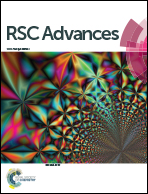Atomic layer deposition-based synthesis of photoactive TiO2 nanoparticle chains by using carbon nanotubes as sacrificial templates†
Abstract
Highly ordered and self supported anatase TiO2 nanoparticle chains were fabricated by calcining conformally TiO2 coated multi-walled carbon nanotubes (MWCNTs). During annealing, the thin tubular TiO2 coating that was deposited onto the MWCNTs by atomic layer deposition (ALD) was transformed into chains of TiO2 nanoparticles (∼12 nm diameter) with an ultrahigh surface area (137 cm2 per cm2 of substrate), while at the same time the carbon from the MWCNTs was removed. Photocatalytic tests on the degradation of acetaldehyde proved that these forests of TiO2 nanoparticle chains are highly photoactive under UV light because of their well crystallized anatase phase.


 Please wait while we load your content...
Please wait while we load your content...